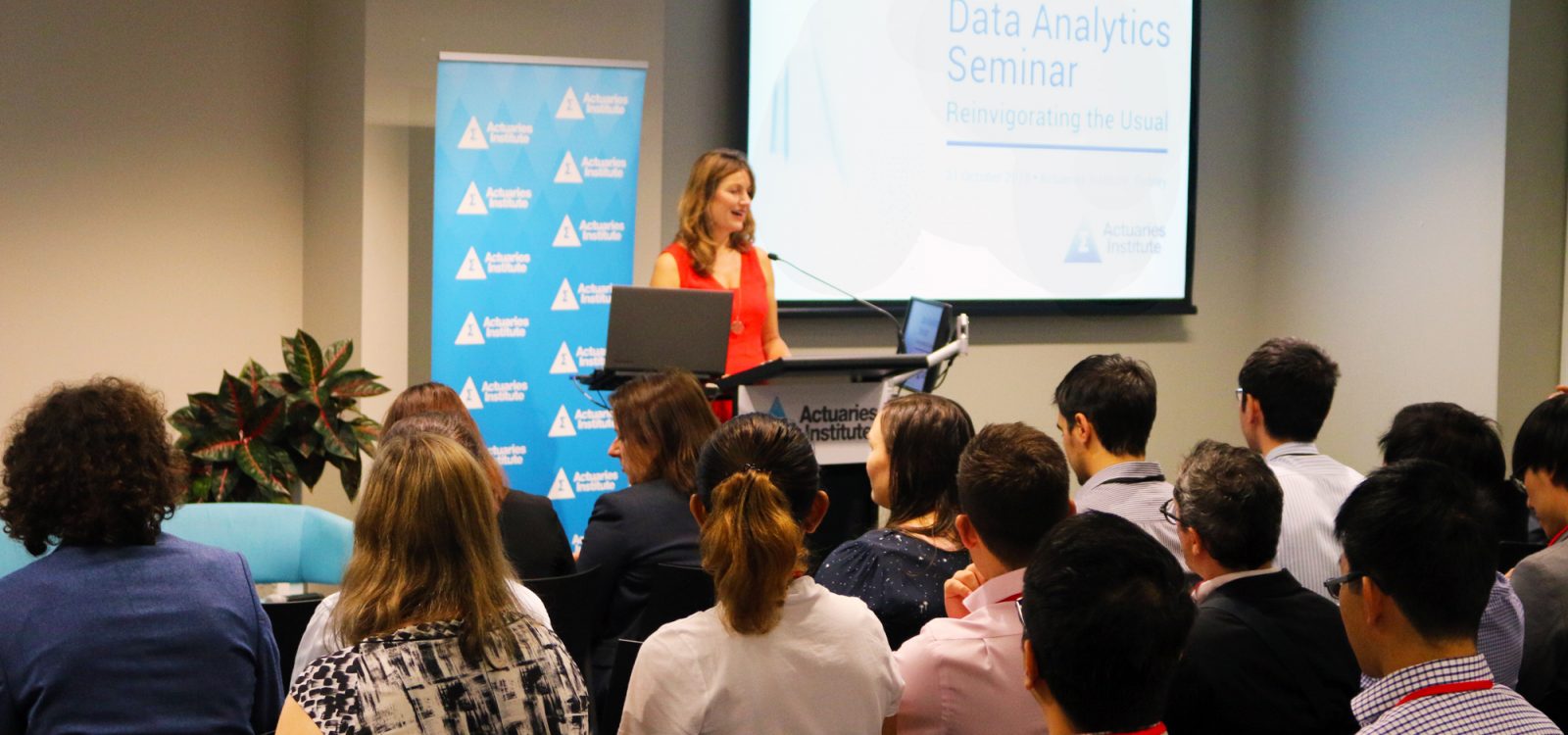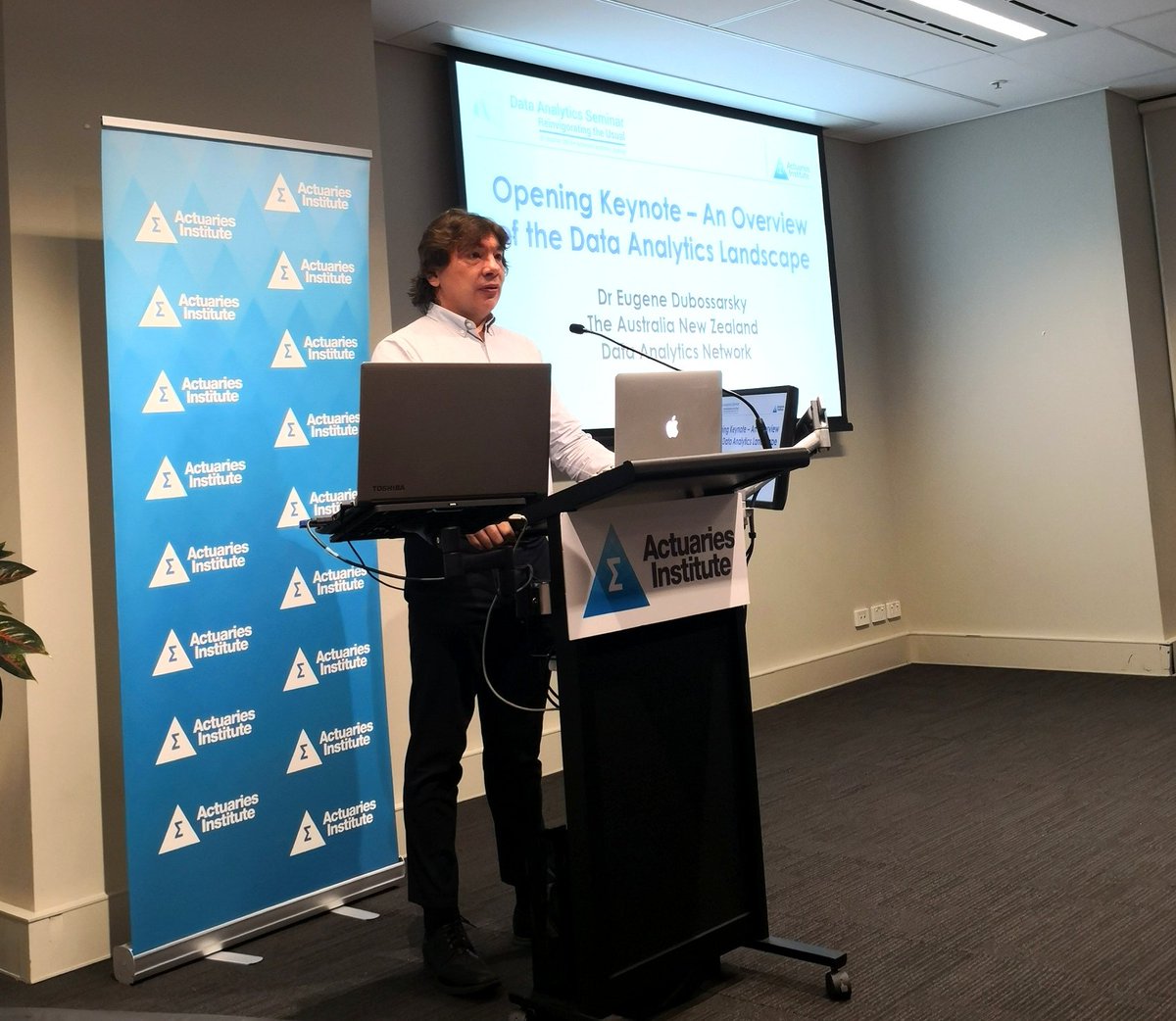
Data Analytics Seminar 2018: Reinvigorating the Usual
The Institute’s annual Data Analytics Seminar was held on the 31st October with a smorgasbord of industry leaders and domain experts discussing a wide variety of topics. The topic for this year’s seminar was “Reinvigorating the Usual” which reflected the ways that data is revolutionising all areas of business, impacting not only “data analytics actuaries” but actuaries working in all fields.
The day covered everything from organisational transformation to data governance, and included 15-minute “microtalks” to demonstrate the latest-and-greatest technologies that actuaries are using in the field and how they can deliver meaningful improvements in businesses.

An Overview of the Data Analytics Landscape
Dr Eugene Dubossarsky (founder of Data Science Sydney and Principal Founder of the Australia New Zealand Data Analytics Network) delivered the opening keynote with an overview of the data analytics landscape and the role that actuaries can, should, and do play in it.
Eugene’s key observation is that these it’s still early days for data analytics. Analytics is in a transitional state, working towards its full potential as organisations improve their data literacy and better understand the purpose, place and capability of data scientists.
What does this mean for actuaries?
“Actuaries are very highly skilled analytics professionals… very capable data scientists. I have a whole lot of good news for actuaries, people with your skillset, who’ve gone through the selection processes that you’ve gone through. People of your calibre, I think, look pretty good in this emerging future.” – Dr Eugene Dubossarsky
What tends to hold actuaries back? Our professional humility, according to Eugene, with the implication that we should have more confidence in our skills and value. It is easy to call oneself a “data scientist” today, and actuaries, while well trained in areas highly relevant to data science, are also taught to manage risk and be professional. Actuaries potentially undersell themselves when facing a data analytics problem, hesitant about embarking on tasks they haven’t necessarily done before.
How are Businesses Implementing Change?
Organisational change was the topic of the first plenary, with unique views being shared by Natalie Nguyen (CEO, Hyper Anna), Ash Nair (Head of Data and Analytics, QBE), and Farhan Baluch (formerly Senior Data Scientist, Netflix) joining via Skype from LA.
A key theme that permeated all three presentations was the importance of a clear vision for analytics-based transformation coupled with finding the right people and aligning them with this vision. Ash highlighted that analytics projects can’t be treated as once-off and due consideration needs to be given to how they will integrate with the broader BAU context. Farhan shared his insights into the typical analytics value chain (Measurement -> Analysis -> Reporting -> Prediction), and Natalie reminded us to support the data analysts that are at the core of analytics-focused change in order to maximise the value they bring organisations.
The Birds-Eye View of Data Governance
The second plenary of the day featured a topic which is becoming fundamental to data analytics work: governance. Two industry leaders delved deeply into the minefield of increasing regulation and evolving public expectations.
Tommy Viljoen (National Lead Partner, Cyber Risk Service Strategy and Governance, Deloitte) likened the current data revolution to the emergence of cars more than 100 years ago. The automobile became extremely popular extremely quickly, which forced legislation and regulation to swiftly adapt and continuously evolve over the decades. Tommy suggested that we’ll likely see a cat-and-mouse affair in data analytics where capability advances, and then regulation develops to keep up.
“We’re only ten years into our journey of how we safeguard data – what’s it going to be like in another 140 years? – Tommy Viljoen
Dean Joscelyne (Founder, IXUP) showed us how data governance is permeating organisations – particularly those that have a lot to gain from collaborative data sharing. He noted that data governance is a key issue on the minds of boards, especially in the finance industry, which has high numbers of reported data breaches.
Staying Relevant in the Digital Age
Customer expectations are evolving quickly, and it’s not necessarily easy to keep up. Liming Zhu (Research Director, CSIRO’s Data61), Jodie Sangster (CMO Liaison, IBM Watson), and Kari Mastropasqua (EGM Data and Analytics, Equifax) set us on the right path by sharing their experiences using data to produce market leading customer experiences.
Liming cemented the importance of data by noting that some of the biggest companies in 2008 – like Exxon, GE and AT&T – are now eclipsed by data driven platforms – like Google, Amazon and Facebook. The value of multi-disciplinary teams was emphasised by Kari, and Jodie shared the four elements that businesses are required to deliver – value, relevance, efficiency and trust.

Evaluating Up-and-Coming Technologies
The data analytics scene is inundated with new technologies threatening to supersede the current best practice and revolutionise our businesses – but not all of them do. Ann Williamson (Professor of Aviation Safety, UNSW) stimulated our critical minds with a “reality check” on self-driving cars and the serious limitations that are rarely discussed.
Core to Ann’s presentation was the concept of human-centered design. To illustrate her point, Ann noted that all self-driving vehicles have limitations that, when triggered, require a human to take over – and questioned whether it’s reasonable to expect a person to be able to respond at a moment’s notice to a situation that might be unfolding at 100km/h. The Q&A identified many parallels with the relationship between humans and algorithms in data analytics.
Microtalks: Actuaries on the Bleeding Edge
Spread throughout the conference were three talks by actuaries about analytics technologies and techniques that they use to solve real world problems.
Zeming Yu showed us LightGBM, a machine learning tool from Microsoft that generates more accurate prediction models quicker, using a Kaggle competition that was centered on identifying safe (and consequently unsafe!) drivers.
An increasingly hot topic in the world of artificial intelligence is “explainability”, which refers the desire to understand how and why models make their predictions. Joshua Jaroudy (Director, Taylor Fry) used credit risk data to demo DALEX and LIME which provide insight into models that can be used to evaluate fairness, guide auditors, and satisfy regulators.
Luke Heinrich presented “An Actuary’s Foray into Text Processing”, walking us through a number of techniques that can be used to extract insight from unstructured text. One of these techniques even allowed us to do arithmetic on words (counterintuitive, but true!) and showed that “actuary – insurance + taxation” gets you very close to “accountant”.

Thank you to our presenters and the Organising Committee who devoted themselves to make the 2018 Data Seminar a success!
CPD: Actuaries Institute Members can claim two CPD points for every hour of reading articles on Actuaries Digital.







